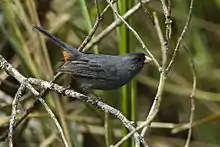Catamenia (bird)
Catamenia is a genus of atypical seedeaters. Formerly placed in the Emberizidae, they are now placed in the tanager family Thraupidae.
| Catamenia | |
|---|---|
 | |
| Plain-colored seedeater (Catamenia inornata) | |
| Scientific classification | |
| Kingdom: | Animalia |
| Phylum: | Chordata |
| Class: | Aves |
| Order: | Passeriformes |
| Family: | Thraupidae |
| Genus: | Catamenia Bonaparte, 1850 |
| Type species | |
| Linaria analis d'Orbigny & Lafresnaye, 1837 | |
| Species | |
|
See text | |
These species are found in more open areas in the Andes and the adjacent lowlands. Males are mainly gray; females are brownish and streaked. Both sexes have a distinctive chestnut crissum.[1]
Taxonomy and species list
The genus Catamenia was introduced in 1850 by the French naturalist Charles Lucien Bonaparte.[2] The name is from the Ancient Greek katamēnia meaning "menstrual" or "menstruous".[3] The type species was designated by the English zoologist George Robert Gray as the band-tailed seedeater in 1855.[4][5] The genus now contains three species.[6]
This genus was traditionally placed with other seed-eating birds in the family Emberizidae.[5] A series of molecular phylogenetic studies published in the first decade of the 21st century found that many genera in Emberizidae were more closely related to the fruit eating birds in the family Thraupidae.[7][8] In the reorganization of the family boundaries, Catamenia was one of several genera moved to Thraupidae.[6]
A genetic study of the Thraupidae published in 2014 found that Catamenia is sister to the genus Diglossa in the subfamily Diglossinae. Within Catamenia, the band-tailed seedeater is sister to a clade containing the plain-colored seedeater and the paramo seedeater.[9]
| Image | Scientific name | Common Name | Distribution |
|---|---|---|---|
 | Catamenia analis | Band-tailed seedeater | Argentina, Bolivia, Chile, Colombia, Ecuador, and Peru |
 | Catamenia inornata | Plain-colored seedeater | Argentina, Bolivia, Chile, Colombia, Ecuador, Peru, and Venezuela |
 | Catamenia homochroa | Paramo seedeater | Bolivia, Brazil, Colombia, Ecuador, Peru, and Venezuela |
References
- Ridgely, Robert S.; Tudor, Guy (2009). Birds of South America: Passerines. Helm Field Guides. London: Christopher Helm. p. 649. ISBN 978-1-408-11342-4.
- Bonaparte, Charles Lucian (1850). Conspectus Generum Avium (in Latin). Volume 1. Leiden: E.J. Brill. p. 493.
- Jobling, James A. (2010). The Helm Dictionary of Scientific Bird Names. London: Christopher Helm. p. 94. ISBN 978-1-4081-2501-4.
- Gray, George Robert (1855). Catalogue of the Genera and Subgenera of Birds Contained in the British Museum. London: British Museum. p. 78.
- Paynter, Raymond A. Jr, ed. (1970). Check-List of Birds of the World. Volume 13. Cambridge, Massachusetts: Museum of Comparative Zoology. p. 152.
- Gill, Frank; Donsker, David; Rasmussen, Pamela, eds. (July 2020). "Tanagers and allies". IOC World Bird List Version 10.2. International Ornithologists' Union. Retrieved 4 November 2020.
- Barker, F.K.; Burns, K.J.; Klicka, J.; Lanyon, S.M.; Lovette, I.J. (2013). "Going to extremes: contrasting rates of diversification in a recent radiation of New World passerine birds". Systematic Biology. 62 (2): 298–320. doi:10.1093/sysbio/sys094. PMID 23229025.
- Remsen, J. Van Jr; Burns, Kevin (2011). "Proposal (512) to South American Classification Committee: Transfer genera from Emberizidae to Thraupidae". South American Classification Committee (SACC) of the American Ornithological Society (AOS). Retrieved 4 November 2020.
- Burns, K.J.; Shultz, A.J.; Title, P.O.; Mason, N.A.; Barker, F.K.; Klicka, J.; Lanyon, S.M.; Lovette, I.J. (2014). "Phylogenetics and diversification of tanagers (Passeriformes: Thraupidae), the largest radiation of Neotropical songbirds". Molecular Phylogenetics and Evolution. 75: 41–77. doi:10.1016/j.ympev.2014.02.006.